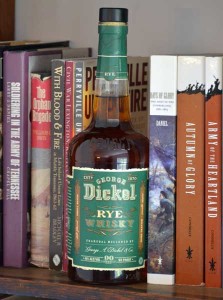George Dickel Rye Whiskey Review
By Richard Thomas
Rating: B

(Credit: Richard Thomas)
To my knowledge, George Dickel Rye is the only rye whiskey that can be labeled “Tennessee Rye Whiskey,” and even then one has to overlook the whiskey’s sourcing. The Dickel Rye is made by Lawrenceburg Distillers Indiana, because as I discovered when I was at Cascade Hollow in May of this year, the Dickel distillery is not equipped to make a rye whiskey. So how can I call it “Tennessee Rye” when it’s not made in Tennessee?
First and foremost, George Dickel Rye is the only rye whiskey made using the maple charcoal-filtered Lincoln County Process. Some have claimed that this process is irrelevant and all Tennessee whiskey is actually bourbon, pointing to a narrow definition of Federal law. Given that Jack Daniel’s will soon likely have a definition for Tennessee whiskey using the Lincoln County Process enshrined not just in American treaties, as it already is, but also in the law books, that hair-splitting caveat will cease to have any merit whatsoever.
So, while the whiskey is made in Indiana, it’s for a classic Tennessee brand using the signature Tennessee process, making the stuff as close to a Tennessee rye as we have at the present time. The only other contender, Jack Daniels white rye, doesn’t count precisely because it isn’t aged.
The Rye
Dickel and Daniels are the only two distilleries using charcoal maple-filtering, and three major points separate Dickel from Daniels: 1) Dickel uses cool (not freezing) chill filtering before the whiskey goes into the barrel, instead of after it comes out; 2) Dickel uses an even deeper vat for its maple charcoal filtering; 3) while not a micro-distillery, Dickel is a small concern, and very far from the mass-producing giant that Daniels is. The George Dickel Rye is a high-rye, with a 95% rye and 5% malted barley mashbill. It’s aged for around five years, and bottled at 9o proof (45% abv).
The coloring is that of bright, polished copper. On the nose, the whiskey smells of toasty oak, floral citrus, and sweet tobacco with drops of vanilla and caramel. As with everything from George Dickel, mellow is a defining characteristic here.
The flavor has a little bit of everything, coming out in a nicely balanced and supremely restrained package. There is a little oak, a little bundle of ginger, vanilla, and cinnamon, some sweet tobacco. It’s spicy, but sweetly so and without being corny or fruity, and above all, silky smooth. The finish is spicy and dry, but still mellow, leaving a moderate and lingering warmth.
I think Dickel is onto something with this rye. Diehard rye fans might want more of a spicy bite, but outside those circles, there are plenty of people who will appreciate this somewhat sophisticated, superbly balanced, and thoroughly mellow whiskey.
The Price
I’ve seen George Dickel Rye on the shelves in Kentucky, Tennessee, Ohio, West Virginia, and DC, as well as online, and it hovers in the $22 to $25 range. Given how good of a mellow sipper this stuff is, and how scarce anything beyond the most basic ryes like Old Overholt seem to be these days, that makes it a real bargain.





Rich Thomas;
Your review is thorough crisp and clear. Your review matches my own thinking and runs contrary to others I have read on George Dickel Rye. After wading through a particular review, I gained the impression that bias was not just a matter of where the Rye whiskey is produced, but suspect in the motivations of the reviewer too. I picked up my second case today and plan on executing some blind tastings against other similarly aged and priced Ryes (Bulleit, etc) to gauge my own attitudes on the matter. I am ostensibly a Scotch drinker, but as a Londoner by origin (read: London, KY) I shall not deny myself good bourbon or the drink of our founders like Washington and Jefferson: that being Rye. I rate the Dickel Rye higher than several of its bourbon siblings by Dickel. Conservatively an 89. Cheers. David
David — I’m glad to see you weren’t deterred by the naysayers.
The prevalence of the LDI/MGP 95% rye stock nowadays raises that question you’ve hit upon: are there any differences in the various versions, and what are the price comparisons. Blending has a lot to do with how a whiskey turns out, so a company with good people in the tasting and blending room can do a lot more with a given lot of stock than would otherwise be the case. Then there are the people who, like Dickel or Angel’s Envy, add to the process in substantial ways.
Only a fool would think all the LDI/MGP rye will taste absolutely the same, but unfortunately there are some fools with blogs out there.